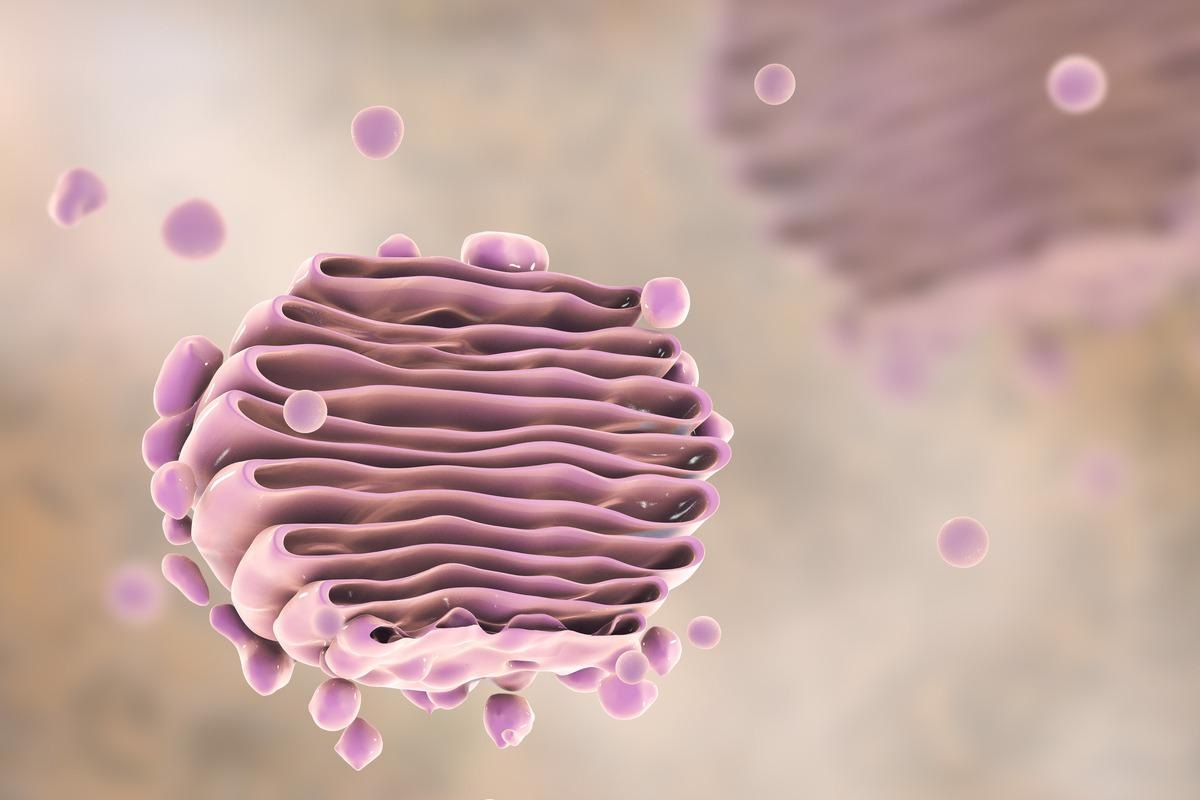In a recent study posted to the bioRxiv* preprint server, researchers observed that Golgi fragmentation induced by severe acute respiratory syndrome coronavirus-2 (SARS-CoV-2) facilitates viral trafficking.
 Study: SARS-CoV-2 triggers Golgi fragmentation via downregulation of GRASP55 to facilitate viral trafficking. Image Credit: Kateryna Kon/Shutterstock
Study: SARS-CoV-2 triggers Golgi fragmentation via downregulation of GRASP55 to facilitate viral trafficking. Image Credit: Kateryna Kon/Shutterstock

 *Important notice: bioRxiv publishes preliminary scientific reports that are not peer-reviewed and, therefore, should not be regarded as conclusive, guide clinical practice/health-related behavior, or treated as established information.
*Important notice: bioRxiv publishes preliminary scientific reports that are not peer-reviewed and, therefore, should not be regarded as conclusive, guide clinical practice/health-related behavior, or treated as established information.
Background
The coronavirus disease 2019 (COVID-19) pandemic caused by SARS-CoV-2 has caused an unprecedented global health crisis triggering national and local lockdowns, mobility restrictions, and (international) travel bans. More than 6 million deaths have been recorded due to COVID-19 to date, with over 453 million infections worldwide.
As it stands, vaccination is the most effective strategy to curb the spread of SARS-CoV-2. Still, the effectiveness of vaccines is compromised when new SARS-CoV-2 variants emerge with novel mutations conferring increased transmissibility and pathogenicity. Therefore, it is critical to comprehensively understand the mechanism of SARS-CoV-2 infection for developing advanced strategies for COVID-19 mitigation.
Viruses are either enveloped or non-enveloped; non-enveloped viruses exit host cells via cytolytic mechanisms, and enveloped viruses use the host secretory pathway. SARS-CoV-2 is an enveloped virus, and its modulatory actions on the endomembrane system for assembly and exit remain unaddressed.
About the study
The current study investigated the interactions between SARS-CoV-2 and the host cell endomembrane system.
The researchers infected Huh7-ACE2 cells (cell line from male hepatoma tissue) with USA-WA1 strain of SARS-CoV-2 and observed significant structural changes in the Golgi system. The Golgi system was fragmented and dispersed throughout the cytoplasm in infected cells. Similarly, clathrin coats, coat protein I (COPI), and COPII were scattered in the cytoplasm.
Since the endomembrane system had considerable morphological changes, the authors speculated that disrupting endomembrane functions could impact SARS-CoV-2 infection. To this end, drugs targeting the endomembrane system were screened; out of 27 selected small molecules, 22 drugs significantly inhibited infection. Tunicamycin (Tm), thapsigargin (Tg), and dithiothreitol (DTT), which are known inducers of endoplasmic reticulum (ER) stress, showed significant SARS-CoV-2 inhibition.
Findings
Golgi modulators like Brefeldin A (BFA) and monensin showed more than 98% inhibition of SARS-CoV-2. Moreover, lysosome inhibitor drugs like bafilomycin A1 (BafA1), Vacuolin-1, a cocktail of protease inhibitors (PIs), leupeptin, E64d, and pepstatin significantly reduced viral infection. Autophagy inhibitors (3-methyladenine or 3-MA) and inducers (Torin-1) inhibited viral infection, albeit lesser than lysosomal inhibitors.
Electron microscope and immunofluorescent analysis of the infected cells were made to elucidate the structural changes of the Golgi compartment. The expression of Golgi reassembly-stacking protein (GRASP65) and 4-Galactosyltransferase 1 (GalT) was unchanged despite the fragmentation of the Golgi complex. Microscopic visualization of the Golgi system revealed an organized, concentrated structure around the perinucleus in the uninfected cells. In contrast, SARS-CoV-2-infected cells displayed disorganized and fragmented stacks, and many virus particles were observed in the Golgi lumen.
SARS-CoV-2 proteins like spike (S), membrane (M), envelope (E), and ORF3a were shown to trigger Golgi fragmentation in Vero E6 cells individually. Golgi protein expression levels were evaluated to understand the molecular mechanisms driving Golgi fragmentation. Expression of GRASP55 was downregulated while that of trans-Golgi network protein 46 (TGN46) increased dramatically upon SARS-CoV-2 infection.
Further, green fluorescent protein (GFP), wildtype GRASP55 tagged with GFP, and GRASP55’s oligomerization domain (GRASP N) were expressed in Huh7-ACE2 cells. Cells expressing either GFP-tagged GRASP55 or GRASP N had significantly lower viral infection rates than GFP-expressing cells. The authors observed that the Golgi system forms an organized, stacked structure with high expression of GRASP55 under normal conditions, but viral infection results in decreased GRASP55 expression leading to Golgi fragmentation facilitating viral trafficking.
The higher expression of TGN46 in SARS-CoV-2-infected cells indicated a possible role in the infection. Knocking down the TGN46 gene negatively affected the SARS-CoV-2 infection rate. Recapitulating the knockdown experiment on cells infected with the Delta variant produced similar results.
Conclusions
The findings revealed that infection with SARS-CoV-2 modulates the host endomembrane system, particularly the Golgi apparatus, and small molecules targeting the Golgi system significantly inhibited viral infection. Golgi fragmentation could be triggered by individual SARS-CoV-2 proteins such as S, M, E, and ORF3a. The expression of two Golgi proteins (TGN46 and GRASP55) was significantly affected in infected cells. Cells with higher expression of GRASP55 strongly inhibited viral infection, and depleted levels of TGN46 had a similar (inhibitory) effect.
Moreover, trafficking of S protein to the cell membrane negatively correlated with the (over)expression of GRASP55, suggesting that SARS-CoV-2-mediated downregulation of GRASP55 could facilitate viral trafficking. Thus, SARS-CoV-2 infection down- and up-regulates GRASP55 and TGN46 expression, respectively. These results suggest that the Golgi apparatus could be a novel therapeutic target in the treatment of SARS-CoV-2 infection.

 *Important notice: bioRxiv publishes preliminary scientific reports that are not peer-reviewed and, therefore, should not be regarded as conclusive, guide clinical practice/health-related behavior, or treated as established information.
*Important notice: bioRxiv publishes preliminary scientific reports that are not peer-reviewed and, therefore, should not be regarded as conclusive, guide clinical practice/health-related behavior, or treated as established information.